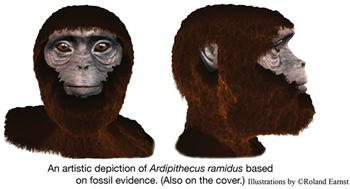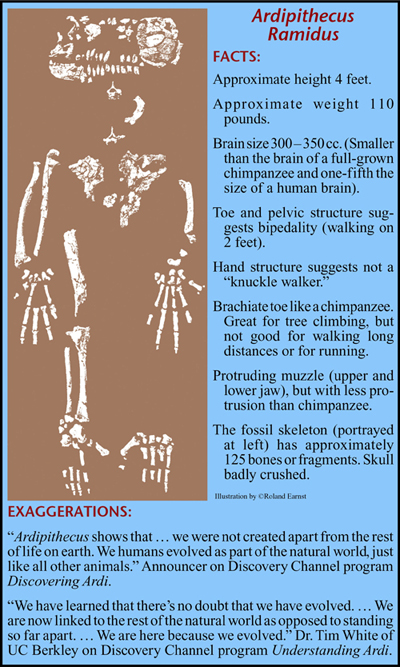In the 42 years that this journal has
been in existence, there has been a long series of “spectacular finds”
of the remains of ancient men or apes. Media hype has always been
extensive about the latest find, and magazines like
National Geographic
have capitalized on public interest in the claims. Neanderthal man has
been a major focus of interest over the years, and in 2009 there were
several detailed articles on Neanderthal man in several popular
publications.
In October of 2009 a major publicity campaign was conducted on a 1994
find named
Ardipithecus ramidus
which has been nicknamed “Ardi.”
Grandiose claims have been made in the press and on TV about this find
and its significance. The fossil skeleton found in Ethiopia consists of
125 pieces and is said to be 4.4 million years old based on radiometric
dating of the volcanic ash layers where it was found.
The interest in Ardi may have been tweaked by the tour of “Lucy” that
was going on throughout the country. Lucy was the most complete
specimen ever found of an early primate and she is significant for that
reason. In spite of the hype, Lucy is pretty much 100 percent monkey.
Her brain size was 421 cc (a chimp is 525). Her mandible (jawbone) was
V shaped
instead of
C
shaped like a human or box shaped like a gorilla.
Her humerus (upper arm bone) and femur (upper leg bone) were the same
size—typical of a monkey. Lucy’s finder (Donald Johanson) has a theory
that apes became erect and that later the brain developed, becoming
human. That view is supported by some indications that Lucy may have
been able to walk in an erect position.
Ardipithecus is older than Lucy. Again there is some evidence that this
animal may have traveled in an erect position. Instead of having a
thumb that was down on the wrist which is helpful for living in the
trees, this animal’s thumb is like ours—near the fingers. The pelvis
and hip of Ardi show that the gluteal muscles were positioned so that
the animal could walk upright. Everything else about the specimen is
pure monkey, like Lucy—small brain (smaller than a modern chimpanzee),
V-shaped
mandible, limb ratios identical, etc.

The excitement among evolutionists in the scientific
community is that it may add some more information to the debate about
the theory of how man became man. The message for all of us is that
there may have been monkeys in the past which could live on the ground
and travel on two legs. Some evolutionists like Dr. Owen Lovejoy of
Kent State University believe that is all that is needed to qualify the
specimen as an ancestor of man. Lovejoy said “When you get to the very
bottom, it is simply bipedality that becomes the defining character of
being human.” The idea is that after apes became erect and started
living on the ground, the brain size increased, ultimately leading to
man.
The name
Ardipithecus ramidus
means “root of the ground ape,”
indicating that the animal may help detail the changes that have
occurred in the ape family. It does not mean that this is an ancestor
to man. The idea that there is a single link that connects man to the
apes is a massive exaggeration. There is a whole series of major
differences between man and other primates. On the earth today there is
but one species of man. A pygmy can interbreed with a Swede and produce
fertile offspring. As
Acts
17 says, “We are all of one blood,” and we
all have common ancestors which the Bible names Eve and Adam. There are
many species of monkeys. That is because monkeys do not have a recent
common ancestor. There has been a great deal of genetic drift and
specialization among the various primates on this planet. This new find
will complicate the picture more, but all of this is really not a major
issue for those who believe the Bible is the Word of God.

The Bible defines human beings in completely different
terms than does the physical anthropologist. The scriptures do not tell
us what Adam looked like (in spite of massive numbers of art works that
show a Caucasian, blue-eyed, blonde-haired, modern human without body
hair). The biblical definition is that man is that being created in the
image of God. All animals have life, but only humans were created in
the image of God. We see that uniqueness displayed in man’s capacity to
worship, to create art and music, to feel guilt, to be sympathetic, and
to have a concept of self. Even though chimpanzees have over 90 percent
of the same genes that we have, we do not see these capacities
displayed even in part in any monkey or ape. This is in spite of many
attempts that have been made to relate these functions to the brain.

The body in which man is housed is not an issue in the biblical
definition. How long ago our ancestors lived is not given in the Bible,
and all methods of trying to determine when God created man are based
on so many assumptions as to be of no use. It is also an assumption to
believe that all that makes up man’s spiritual nature is produced by
natural processes.
Ardi is an interesting specimen, and gives us more information about
how diverse the various primates have been throughout time. It will be
interesting to watch those who wish to deny man’s unique nature as a
spiritual being try to integrate Ardi and Lucy into a model that will
satisfy them. The Bible gives no information about how God “formed man
of the dust of the Earth” (
Genesis
2:7). Those who believe it was an
instantaneous, manual creation should not feel threatened by
investigations of ancient primates or by the theories of evolutionists
as to how the changes might have led to modern man. Those theories will
always be just imaginative proposals, and will never really explain
what makes us spiritual human beings and not just mechanically driven
robotic animals.



 The excitement among evolutionists in the scientific
community is that it may add some more information to the debate about
the theory of how man became man. The message for all of us is that
there may have been monkeys in the past which could live on the ground
and travel on two legs. Some evolutionists like Dr. Owen Lovejoy of
Kent State University believe that is all that is needed to qualify the
specimen as an ancestor of man. Lovejoy said “When you get to the very
bottom, it is simply bipedality that becomes the defining character of
being human.” The idea is that after apes became erect and started
living on the ground, the brain size increased, ultimately leading to
man.
The excitement among evolutionists in the scientific
community is that it may add some more information to the debate about
the theory of how man became man. The message for all of us is that
there may have been monkeys in the past which could live on the ground
and travel on two legs. Some evolutionists like Dr. Owen Lovejoy of
Kent State University believe that is all that is needed to qualify the
specimen as an ancestor of man. Lovejoy said “When you get to the very
bottom, it is simply bipedality that becomes the defining character of
being human.” The idea is that after apes became erect and started
living on the ground, the brain size increased, ultimately leading to
man. The Bible defines human beings in completely different
terms than does the physical anthropologist. The scriptures do not tell
us what Adam looked like (in spite of massive numbers of art works that
show a Caucasian, blue-eyed, blonde-haired, modern human without body
hair). The biblical definition is that man is that being created in the
image of God. All animals have life, but only humans were created in
the image of God. We see that uniqueness displayed in man’s capacity to
worship, to create art and music, to feel guilt, to be sympathetic, and
to have a concept of self. Even though chimpanzees have over 90 percent
of the same genes that we have, we do not see these capacities
displayed even in part in any monkey or ape. This is in spite of many
attempts that have been made to relate these functions to the brain.
The Bible defines human beings in completely different
terms than does the physical anthropologist. The scriptures do not tell
us what Adam looked like (in spite of massive numbers of art works that
show a Caucasian, blue-eyed, blonde-haired, modern human without body
hair). The biblical definition is that man is that being created in the
image of God. All animals have life, but only humans were created in
the image of God. We see that uniqueness displayed in man’s capacity to
worship, to create art and music, to feel guilt, to be sympathetic, and
to have a concept of self. Even though chimpanzees have over 90 percent
of the same genes that we have, we do not see these capacities
displayed even in part in any monkey or ape. This is in spite of many
attempts that have been made to relate these functions to the brain.
